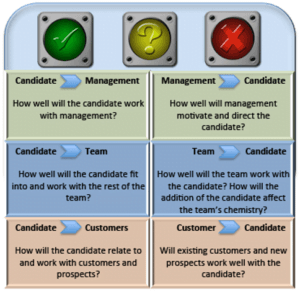Does Your Resume Create Results?
In any job market, it’s important to present a comprehensive resume, but when it’s a competitive...
Read More
As the economy and demand for great employees continue to be red hot, we employers are confronted with making more hires in a competitive market that requires rapid decision making – which is not always optimal.
Quick is often NOT GOOD, but if you are going to be in a position where you are making fast decisions on people – the most important ingredients to success in your company – you need to have a process for evaluation that can be used simply, easily, and WITH CONSISTENCY.
As experts in connecting companies with highly qualified candidates, StevenDouglas knows a thing or two about hiring strategies. Here are some of our top tips for improving your recruitment strategy.
Face it, hiring is a sporadic activity, and few companies/people are great at it. We aren’t equipped with great tools to guide us in making hiring decisions, and we often lack a strategy that results in the pursuit of the best people because we are not prepared to understand what “best” really means. Often, that means we hire the first person who satisfies minimal qualifications rather than hold out for the best person we can find.
However, that can lead to high turnover, low employee satisfaction, and frustration amongst leadership in your organization because they aren’t getting the top talent they need to help your company excel. This makes having a fine-tuned recruitment strategy a necessity rather than a luxury.
When developing an interview strategy, think about how you interview, and use a simple set of business tools to guide your decision-making. While skills will always remain a must-have – if the candidate lacks the skills you require, nothing will make them the right choice – don’t forget to look beyond the skills.
We tend to fall in love with a resume and forget that we, our team, and our clients will be working with that new employee every day. Forgetting about FIT can be a fatal error – so to make sure you consider fit, use this simple “Red Light, Green Light” test and it will allow you to make better hires EVERY TIME!
But measuring fit is hard, right? Not if you use the right business tool. This test will enable you to evaluate how the job candidate will fit with the three main constituencies every employee is engaged with.

Ask yourself the questions in the grid above and look at your answers carefully.
Yet, most employers base their decisions on the candidate’s knowledge and then hope for fit. The result is turnover that is higher than you want it to be or worse, you are stuck with a sub-optimal hire that you don’t know how to dismiss.
Business tools are often process models – and simple process models are more likely to make an impact because they can be followed by everyone. This six-stop, red light, green light process model is an easy way to determine if you have interviewed sufficiently to make the right hiring decision – and if you should move forward with an offer or decide to pass.

To help you get the answers you need to do the Red Light, Green Light test, here are some interview strategies you should consider.
The better prepared you are ahead of the interview process, the easier it will be to get the information you need to decide which candidates will best fit the position. Prepare a list of general questions to ask each interviewee along with specific questions you have based on each person’s resume.
While the supervisor who will oversee the new hire is usually the person to do the first interview, you might consider having other team members who will work with the new employee join in the interview process to get an idea about how team dynamics might work and get a fuller picture about how the candidate may fit into your company.
In addition to mentioning the functional benefits you offer, such as health plans, flexible work arrangements, paid time off, compensation, and anything else that sets your company apart, you should discuss your company’s culture and the emotional benefits of your brand.
Not only will that help potential employees decide whether they want to work for you, but their responses can help give you an idea about if the candidate will match your company’s culture. A candidate with all the right skills on their resume may not be the right fit if they have different values and don’t seem to embrace your company’s brand.
Start with the interview questions and listen carefully to how the candidates reply. Wait until the end of the interview to discuss your overview of the company and the position so you don’t accidentally influence job seekers to provide the answers they think you’re looking for rather than giving their most honest replies.
How much information can you really get from a candidate’s well-scripted reply to common interview questions like, “Where do you see yourself in 5 years?” Instead, get a sense of how they think on their feet with less common questions, such as:
Using these tips will not only make better hires; you will eliminate bad hires – and improve business performance as a result. By putting FIT foremost in the minds of interviewers, you will be more likely to build strong, loyal, effective teams that help grow your business year after year.
If you need help finding the perfect candidates, StevenDouglas can help. We’re the #1 recruiting firm in Florida and one of the fastest-growing recruiting firms in the United States, and we have locations all across the US. For more information, please visit Help Me Hire Leaders.
 About the Author:
About the Author:
Donald J. Zinn is Senior Vice President – Executive Search and a senior member of the StevenDouglas search team. Don helps clients in NYC, Westchester, Southern CT, NJ and all over the USA to scale their organizations by identifying and landing the right talent in their quest to find the very best business leaders for their organizations. He focuses on helping fast growing companies build optimal and functional leadership teams. Don holds a BS in Industrial & Labor Relations from Cornell University and an MBA from New York University.
To learn more about me, and get to the StevenDouglas website, check out my video: https://www.stevendouglas.com/